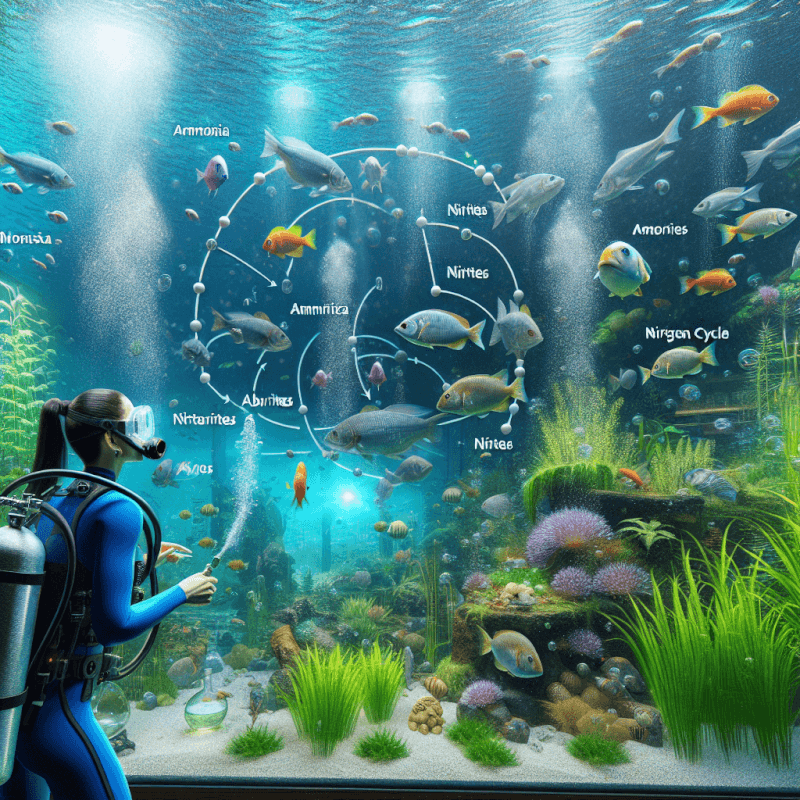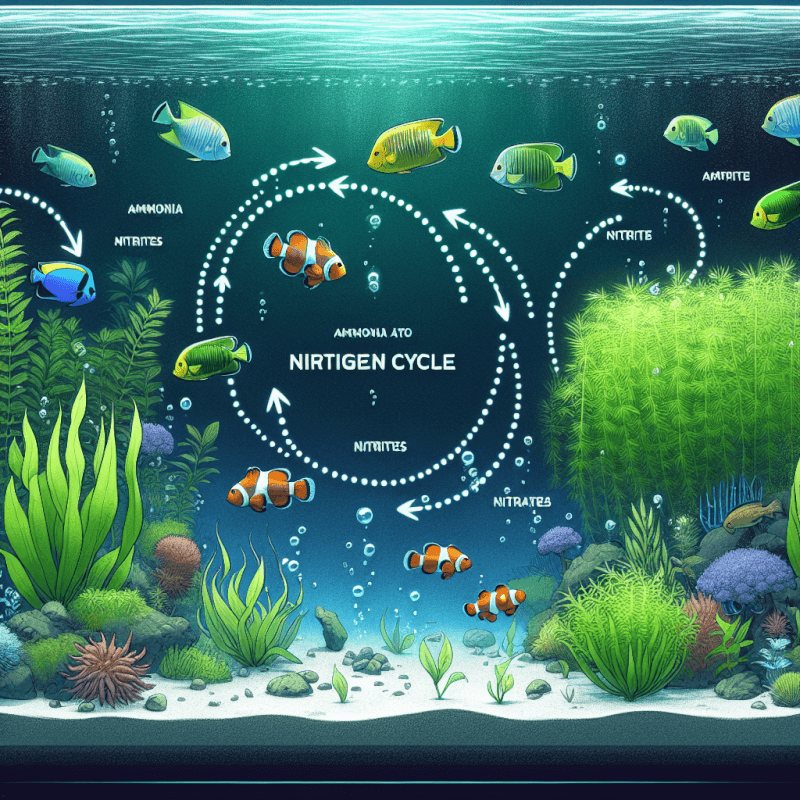Imagine having a thriving aquarium filled with colorful fish and lush aquatic plants, creating a mesmerizing underwater world right in your own home. But have you ever wondered how this delicate ecosystem is maintained? Enter the nitrogen cycle – a fundamental process that ensures the health and balance of your aquarium. In this article, we will explore the fascinating world of the nitrogen cycle, shedding light on its significance and the role it plays in creating a harmonious environment for your aquatic companions. So, let’s dive in and unravel the secrets of the nitrogen cycle in aquariums!
What is the nitrogen cycle in aquariums?
Aquariums are fascinating ecosystems that require careful maintenance to keep the fish and other aquatic life healthy. One of the most crucial processes that take place in an aquarium is the nitrogen cycle. The nitrogen cycle is a natural process that converts potentially toxic ammonia into less harmful nitrate compounds. Understanding this cycle is vital for maintaining a balanced and thriving aquarium environment. In this article, we will explore the basics of the nitrogen cycle, the roles of different nitrogen compounds, the sources of nitrogen in the aquarium, the importance of beneficial bacteria, the different stages of the cycle, how to cycle a new aquarium, and how to maintain the nitrogen cycle in established aquariums.
Ready for Cat Trivia?
Test your knowledge about cats!

The Basics of the Nitrogen Cycle
The nitrogen cycle is a biological process that occurs in all aquariums, converting harmful ammonia into less toxic compounds. It involves the transformation of ammonia into nitrite and further into nitrate, which is relatively harmless to fish and other aquatic organisms. This cycle is crucial for maintaining water quality and ensuring the well-being of the aquarium inhabitants.
Role of Ammonia in the Nitrogen Cycle
Ammonia is the primary waste product produced by fish and other aquatic organisms. It is highly toxic and can lead to fish stress, illness, and even death if not efficiently eliminated. In the nitrogen cycle, certain beneficial bacteria, known as nitrifying bacteria, convert ammonia into nitrite through a process called nitrification. It is essential to monitor and control the levels of ammonia in the aquarium to ensure the health and vitality of the aquatic life.

Role of Nitrite in the Nitrogen Cycle
Nitrite is the intermediate product of the nitrogen cycle that forms when ammonia is converted by nitrifying bacteria. While less toxic than ammonia, excessive nitrite levels can still be harmful to fish and other aquatic organisms. Another group of beneficial bacteria, called nitrite-oxidizing bacteria, convert nitrite into nitrate. Keeping the nitrite levels in check is crucial to prevent stress and potential disease in the aquarium inhabitants.
Role of Nitrate in the Nitrogen Cycle
Nitrate is the final product of the nitrogen cycle. Although it is the least toxic form of nitrogen, high nitrate levels can still pose a risk to the health of the aquarium’s inhabitants. It is generally recommended to keep nitrate levels below 20-40 ppm (parts per million). Routine water changes and the presence of live plants can help to maintain nitrate levels within the acceptable range.

Sources of Nitrogen in the Aquarium
The nitrogen compounds in an aquarium primarily come from the waste produced by fish and other aquatic organisms. Uneaten food, decaying plants, and other organic matter also contribute to nitrogen levels in the aquarium water. Overfeeding and overstocking the aquarium with too many fish can result in excessive nitrogen levels, leading to an imbalance in the nitrogen cycle.
Beneficial Bacteria in the Nitrogen Cycle
Beneficial bacteria play a crucial role in the nitrogen cycle of an aquarium. Nitrifying bacteria convert ammonia into nitrite, and nitrite-oxidizing bacteria further convert nitrite into nitrate. These bacteria help to break down and detoxify harmful nitrogen compounds, ensuring a healthy environment for the aquarium inhabitants. To promote the growth of beneficial bacteria, it is important to provide a proper substrate, maintain a stable pH, and have adequate oxygenation in the aquarium.

Stages of the Nitrogen Cycle
The nitrogen cycle is divided into several stages, each involving specific bacteria and chemical processes. The first stage is the conversion of ammonia into nitrite by nitrifying bacteria. The second stage involves the conversion of nitrite into nitrate by nitrite-oxidizing bacteria. It is important to allow the nitrogen cycle to complete before introducing fish into a new aquarium, as the presence of beneficial bacteria is essential for maintaining water quality.
Cycling a New Aquarium
Cycling a new aquarium involves establishing the nitrogen cycle before adding fish or other aquatic organisms. This process usually takes four to six weeks and requires patience. To initiate the cycle, a source of ammonia is needed, which can be provided through fishless cycling or by adding a small number of hardy fish. Regular water testing, monitoring ammonia, nitrite, and nitrate levels, and performing partial water changes are essential during the cycling process.

Nitrogen Cycle Maintenance in Established Aquariums
Once an aquarium has completed the initial nitrogen cycle, it is necessary to maintain the cycle to ensure the continued health of the aquarium’s inhabitants. Regular water testing should be performed to monitor ammonia, nitrite, and nitrate levels. Partial water changes and vacuuming the substrate can help remove excess nitrogen compounds. Additionally, keeping an eye on fish feeding habits, not overstocking the aquarium, and properly maintaining the filter system are essential for preventing imbalances in the nitrogen cycle.
Testing and Monitoring the Nitrogen Cycle
Regular testing and monitoring of the nitrogen cycle parameters are vital for maintaining a healthy aquarium environment. Ammonia, nitrite, and nitrate test kits are readily available and provide accurate measurements of these compounds. Testing should be conducted regularly, especially during the initial cycling process, and whenever there are signs of stress or illness in the aquarium’s inhabitants. By keeping a close eye on the nitrogen cycle, necessary adjustments can be made to maintain optimal water quality and the well-being of the aquarium’s occupants.
In conclusion, understanding the nitrogen cycle is crucial for any aquarium enthusiast. It is a complex yet essential process that converts toxic ammonia into less harmful nitrate compounds. By ensuring the presence of beneficial bacteria, monitoring ammonia, nitrite, and nitrate levels, and maintaining a well-balanced aquarium environment, you can provide a safe and thriving habitat for your aquatic pets. Happy fishkeeping!



